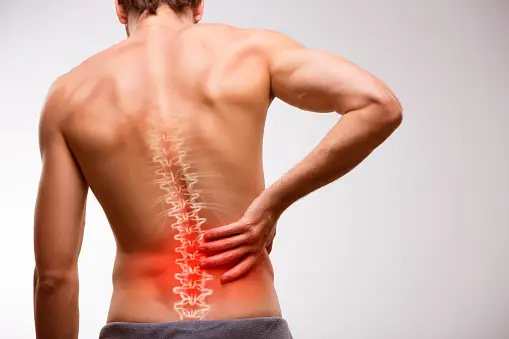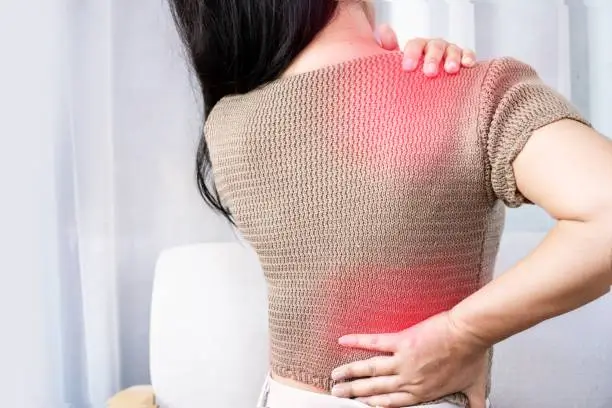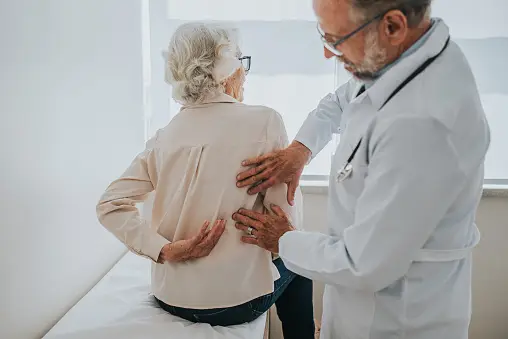Almost 80% of people will experience back pain at some point in their lives, making it one of the most prevalent forms of pain in the world. It may feel like a sudden, searing pain, dull soreness, stiffness, or burning that travels down your legs and buttocks. It can affect the upper to lower back. There are numerous potential reasons of back pain, such as age-related deterioration of the spine, inflammatory diseases like arthritis, and injuries.
Back discomfort, whether acute (short-term) or chronic (long-term), can have a major impact on your day-to-day functioning, limiting your mobility and range of motion, interfering with your sleep, and depressing you. Even while it could be tempting to ignore back pain, doing so can hinder healing, make the pain worse, and lower your quality of life. The greatest method to avoid complications and lead as pain-free a life as possible when dealing with back pain is to seek medical assistance.
Table of Contents
Which Structures Are Behind Them?

The spine serves as the framework for your body, enabling it to move and have its proper shape. Although you might not give your spine much thought until you start having back pain, understanding the anatomy of the back will help you better understand how and why back pain arises. An overview of the structures that comprise your back is shown below:
- Vertebrae: There are 26 bones in the spine, or backbone (vertebrae). Your body is structurally supported by these bones, which are arranged in a vertical row from the base of the skull to the lower back.
- Intervertebral discs: Cushion-like formations that serve as “shock absorbers” in between each vertebra, preventing bones from grating against one another and transmitting pressure uniformly throughout the spine.
- Spinal cord: A lengthy network of nerves that runs through the spine and is used to send messages from the body to the brain.
- Ligaments: Robust connective tissues that support and stabilize the vertebrae of the spine.
- Facet joints: Tiny joints that unite the spinal vertebrae, giving the spinal column stability and enabling controlled movement.
- Muscles: In addition to supporting motions like bending, twisting, standing, and lifting, the back’s network of muscle tissues also gives the entire body stability and support.
Sections of the Spine

There are three sections of the spine:
- Cervical spine (neck): Spans the cranium and ends at the shoulders, supporting head and neck motions.
- Thoracic spine (middle back): Connects the spine to the rib cage, extends from the base of the neck to the posterior (back) abdominal region, and gives the upper body support.
- Lumbar spine (lower back): In addition to supporting the weight of the upper body, the lower back makes twisting, bending, and lifting easier.
How Back Pain Presents

Back pain can affect people in many different ways. Any portion of your back could be affected, and the pain could be minor or so severe that it interferes with your ability to walk, sleep, or work. Back pain can be classified as chronic (long-term), enduring for three months or more, or acute (short-term), lasting a few days or weeks.
Whether your back pain is intermittent or persistent, it could feel like:
- Dull pain
- Sharp, piercing aches
- Legs, buttocks, or hips experiencing a burning or radiating pain from the back
- Stiffness
- Soreness
- Incapacity or difficulty lifting or transporting objects
- Sciatica is the term for numbness or tingling in specific areas of the back, legs, and feet.
Depending on what’s causing it, back pain can get worse while you sit or lie down and get better when you move, or it can get worse when you bend, lift something, or walk.
Possible Reasons for Back Pain

Numerous factors can contribute to back discomfort, such as injuries, mechanical or structural issues with the spine, and inflammatory disorders.
Ligament or Muscle Injuries
One of the most typical reasons of back pain is damage to the muscles or ligaments. Muscle strain can result by lifting large objects, making abrupt movements, accidents (such falls), and gradually using too much force on the muscles. Ligaments sprains happen when they are ripped, frequently by abrupt movements, twisting, or accidents. Ligaments are fibrous fibers that link and maintain bones in place.
Muscle spasms, edema, and discomfort that spreads to the buttocks are frequently observed in cases of muscle strains and ligament sprains. You can be painfully stiff, find it difficult to keep your posture straight, or have restricted range of motion.
In 10 to 14 days, most muscle or ligament injuries heal with rest and ice therapy (applying ice to the injured area). Sometimes, pain can last longer than two weeks and necessitate further care, such as physical therapy.
Structural Problems
An irregularity in any of the bones, joints, discs, or ligaments that comprise the spinal column is indicative of a structural issue with the spine. Back discomfort may result from these anomalies that alter the spine’s support, position, or form.
- Herniated disc: An intervertebral disc can fall out of place due to trauma or severe strain on the spine; this most frequently occurs in the neck or lower back. Sharp discomfort or numbness that travels to other parts of the body, such as the buttocks, hips, legs, shoulders, and arms, can be caused by a slipped disc.
- Degenerative disc disease (DDD): As you age, the gel-like intervertebral discs degrade and the vertebrae (bones) grind against one another. With DDD, your range of motion may be limited and pain may intensify following specific activities (such as bending, sitting, lifting, and twisting).
- Scoliosis: The back’s muscles, joints, and nerves may be unevenly compressed by an abnormal sideways curvature of the spine, resulting in discomfort that is typically felt in the lower and middle back.
- Kyphosis: An excessive curvature of the upper back results in a slouched or “hunchback” posture. Common signs of kyphosis include pain, stiffness, and discomfort in the middle and lower back.
- Spinal stenosis: Compression of nerves by a narrowing of the spinal canal can result in lower back discomfort, leg numbness, stiffness, weakness, and cramping in the muscles.
- Facet joint problems: Sharp lower back pain that travels down the legs is often caused by injury or age-related wear and tear in the tiny joints that link the spinal vertebrae. Facet joint issues may be the cause of anywhere between 15% and 45% of cases of lower back discomfort.
Inflammatory Conditions

Back discomfort can result from diseases that inflame the sacroiliac joints, which connect your lower back to your pelvis. From mild to severe, inflammatory back pain can cause stiffness, aching, or burning feelings. Back discomfort is often related with inflammatory disorders such as:
- Spondyloarthritis Axial : A type of autoimmune arthritis that is persistent and mostly affects the spine and hips. Back discomfort from axial spondyloarthritis typically gets better with movement during the day and gets worse in the morning or right after sleeping.
- Osteoarthritis: Lower back discomfort, stiffness, restricted range of motion, and difficulties moving can be caused by the degeneration of cartilage in the spine’s joints. These symptoms are generally more severe in the mornings or after physical exertion.
- Enteropathic arthritis: A type of long-term, inflammatory arthritis that affects the sacroiliac joint and produces lower back discomfort; commonly seen in patients with inflammatory bowel disease (IBD).
- Psoriatic arthritis (PsA): A type of arthritis that causes inflammation and impacts the joints and skin. Back pain and stiffness are caused by inflammation affecting the spine, which affects about 20% of individuals with PsA.
- Reactive arthritis: Reactive arthritis, which can be brought on by an infection elsewhere in the body, can inflame the sacroiliac joint, which can result in lower back pain and stiffness.
Other Requirements
Back discomfort can be brought on by certain medical problems, such as:
- Kidney stones or infections
- Pregnancy
- Endometriosis, a disorder where tissue resembling uterus grows outside the uterus, resulting in excruciating discomfort in the pelvic region
- Fibromyalgia is a persistent pain and discomfort illness that affects the entire body.
- Bone diseases affecting the vertebrae of the spine
- Tumors
How Can Back Pain Be Identified?

Next only to the common cold and the flu, back pain is one of the most common reasons individuals see their doctors. Your healthcare practitioner will examine you physically, go over your medical history, ask you about your symptoms, and request diagnostic testing to find out what’s causing your back pain.
Your healthcare professional will inquire about the specifics of your pain, such as its location, intensity, duration, and triggers or aggravating factors. Based on your symptoms and level of discomfort, your doctor might prescribe one or more diagnostic tests, such as:
- Imaging tests: Your back’s structures, such as its bones, discs, ligaments, muscles, and nerves, can be seen with the use of computed tomography (CT), MRI, and X-rays. This can assist your physician in identifying anomalies like as fractures, disc herniations, and other structural issues.
- Blood tests: Blood tests can be used to search for indicators of underlying medical disorders, such as inflammatory diseases.
- Electromyography (EMG): This test looks for issues with the muscles and nerves by measuring the electrical activity in the muscles.
- Bone scan: During a bone scan, a tiny quantity of radioactive material is used to view details in the spine, such as fractures, infections, and other anomalies.
Your primary healthcare practitioner may recommend you to a specialist for further diagnostic testing or therapy, depending on the underlying reason of your back pain. Back pain specialists with experience include:
- Orthopedists: Physicians with specific expertise in disorders of the bones and joints
- Neurologists: Physicians with specific expertise in problems of the brain, spine, and nerves
- Rheumatologists: Physicians who focus on the treatment of autoimmune and musculoskeletal conditions
- Physical therapists: Medical professionals who focus on mobility and strengthening exercises to increase function and flexibility
- Physiatrists: Physicians with expertise in treating disorders of the spine, nerves, and brain
How Is Pain in the Back Treated?
Back pain can be effectively treated with a variety of approaches, such as dietary changes, pharmaceuticals, and specialized care. To assist you find relief, your healthcare professional will suggest a customized treatment plan based on the kind and degree of your back pain.
Changes in Lifestyle
Back pain can be managed at home with the aid of lifestyle changes and treatments that can keep the pain from getting worse. Your medical professional might advise:
- Relax: Taking breaks from physically demanding tasks enables your body to repair and rejuvenate.
- Heat/ice therapy: To improve healing, decrease inflammation, and enhance blood flow, apply heat and ice to the injured area.
- Stretches and mild workouts: A physical therapist or healthcare professional may prescribe specific stretches and exercises that can strengthen muscles, increase flexibility, and stop back pain from coming back or getting worse.
- Keep your posture straight: Maintain proper posture when sitting, standing, carrying heavy objects, and sleeping to lessen the strain on your back.
Giving up smoking can aid in the healing process and reduce your chance of developing persistent back pain. Reducing the strain and demand on your spine by maintaining a healthy body weight may assist safeguard the health of your spine.
Chronic stress can exacerbate pain, therefore managing your stress levels and enhancing your quality of life can be achieved by practicing stress-reduction strategies including breathing exercises, meditation, and muscle relaxation.
Medications
Prescription and over-the-counter medications can both aid in the reduction of pain and inflammation. Depending on the degree and underlying reason of your back pain, your doctor might suggest or prescribe:
- Nonprescription analgesics: Pain and inflammation can be controlled with the use of drugs like acetaminophen (Tylenol) and ibuprofen (Advil).
- Relaxants for muscles: Muscle relaxants, both prescription and over-the-counter (OTC), can ease back discomfort and spasms in the muscles.
- Opioid analgesics: When a patient has severe back pain, medical professionals may recommend opioid painkillers. Due to their strong addictive qualities, these drugs are often only used temporarily as they prevent the perception of pain.
- Depression-fighting drugs: By altering the amounts of specific neurotransmitters, or chemicals in the brain, these medications may be able to relieve chronic back pain.
- Corticosteroids: Steroids used orally, intravenously, or by injection can assist temporarily relieve pain and inflammation.
Physical Medicine
Physical therapy may be beneficial for those who suffer from persistent back pain. A physical therapist develops a customized training regimen that includes specific exercises to assist increase range of motion, flexibility, and muscle strength. In order to help treat back pain, they also offer information on self-management approaches like good posture and movement patterns.
Surgery
When conservative measures fail to relieve a particular source of back pain, surgery may be required. For the treatment of fractures, spinal stenosis, herniated discs, nerve compression, or nerve injury, your healthcare professional might suggest surgery. But back and spine surgery frequently carries a high risk and requires a lengthy recovery period.
A Brief Recap
Almost 80% of people will experience back pain at some point in their lives, making it one of the most prevalent forms of pain in the world. Back pain can range in severity from minor to severe and be caused by injury, inflammatory disorders, age-related degeneration, and certain medical conditions.
You may experience negative effects on your physical and mental health if you have chronic back pain. Fortunately, back pain can be managed with the use of at-home therapies, lifestyle changes, prescription drugs, and physical therapy.

Oh, so good for me, thanks!